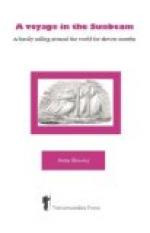Our coachman was becoming impatient, so we bade farewell to our host, and resumed our journey. We crossed innumerable streams on our way, generally full not only of water, but also of bathers; for the Tahitians are very fond of water, and always bathe once or twice a day in the fresh streams, even after having been in the sea.
In many places along the road people were making hay from short grass, and in others they were weighing it preparatory to sending it into town. But they say the grass grown here is not at all nourishing for horses, and some people import it from Valparaiso.
The road round the island is called the Broom Road. Convicts were employed in its original formation, and now it is the punishment for any one getting drunk in any part of the island to be set to work to sweep, repair, and keep in order a piece of the road in the neighbourhood of his dwelling. It is the one good road of Tahiti, encircling the larger of the two peninsulas close to the sea-shore, and surmounting the low mountain range in the centre of the isthmus.
Before long we found ourselves close to Taravao, the narrow strip of land connecting the two peninsulas into which Tahiti is divided, and commenced to ascend the hills that form the backbone of the island. We climbed up and up, reaching the summit at last, to behold a magnificent prospect on all sides. Then a short sharp descent, a long drive over grass roads through a rich forest, and again a brief ascent, brought us to our sleeping-quarters for the night, the Hotel de l’Isthme, situated in a valley in the midst of a dense grove of cocoa-nuts and bananas, kept by two retired French sailors, who came out to meet us, and conducted us up a flight of steps on the side of a mud bank to the four rooms forming the hotel. These were two sleeping apartments, a salon, and a salle a manger, the walls of which consisted of flat pieces of wood, their own width apart, something like Venetian shutters, with unglazed windows and doors opening into the garden.
We walked about four hundred yards along a grassy road to the sea, where Mabelle and I paddled about in shallow water and amused ourselves by picking up coral, shells, and beche-de-mer, and watching the blue and yellow fish darting in and out among the rocks, until at last we found a place in the coral which made a capital deep-water bath. Dressing again was not such a pleasant affair, owing to the mosquitoes biting us in the most provoking manner. Afterwards we strolled along the shore, which was covered with cocoa-nuts and driftwood, washed thither, I suppose, from some of the adjacent islands, and on our way back to the hotel we gathered a handful of choice exotics and graceful ferns, with which to decorate the table.




